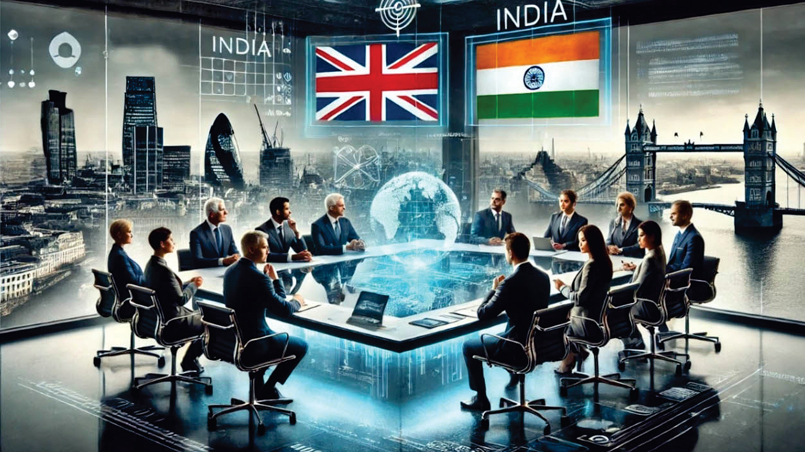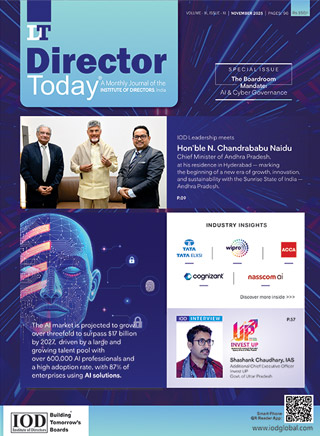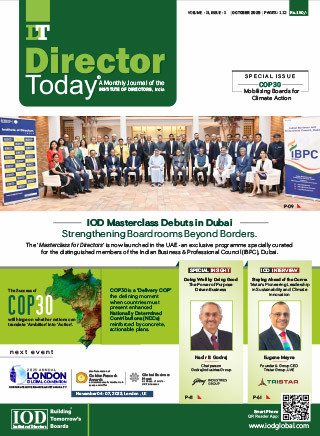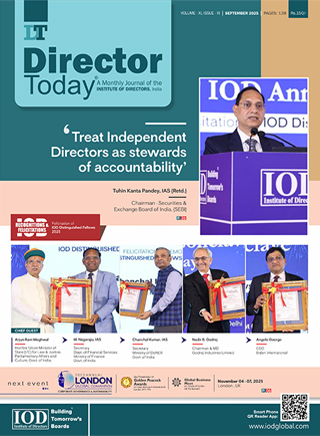Disruptions in Supply Chain: How to navigate it?

As board directors, we must keep in mind that trends come around in cycles - financial, pandemics, international strife, global/regional alliances, etc. In this present climate of uncertainty, businesses are expected to navigate complex geopolitical landscapes, adapt to technological advancements and security threats, while maintaining integrity, transparency, and trust. The elevation of uncertainty around geopolitical risks is materially reshaping decades of established treaties and agreements with unavoidable financial, business, and market consequences. Compounding this is the growing trend of grievance and zero-sum thinking among countries and populations all which combine to pose a serious threat to the rule-based order that has stood for the past 80 years.
Consider companies in US, Canada, and Mexico with investments and supply chains that have historically benefited from the mutual close geographical proximity with little incentive to diversify. As such, Canada's sells its crude oil exports to the US via land pipelines in addition to relying on the US for most of its fresh fruits and vegetables due to its harsh winters and short growing seasons. Decoupling from this can seriously impact the Canadian domestic economy, a task more nuanced for perishable foods due to shipping duration and costs. Trading directly with Mexico is also no panacea because Mexican products travel through US warehouses before heading to Canada by road. Therefore, Canadian crude oil firms JULY 2025 I DIRECTOR TODAY © Institute of Directors, India I www.iodglobal.com 27 have seized the newly opened $34 billion Trans Mountain pipeline as the opportunity to diversify and seek new buyers in Asia where refineries are thirsty for Canadian crude products. As for Mexico, it has developed a huge and sophisticated manufacturing base. Current tensions are pushing some firms to review how to lessen their dependency on US markets by seeking customers in the Americas, Europe and beyond.
South America is also contending with the Sino-American rivalry. It is a continent rich in commodities. Its two largest economies (Brazil and Argentina) are major exporters of soybeans, beef, and oil. Brazil is also a major producer and exporter of iron ore, in addition to being the world's largest producer and exporter of coffee beans. Another notable commodity is copper which comes from Chile and Peru – with the former alone accounting for over a quarter of the global output. South American firms are finding opportunities within a risky and uncertain environment. For example, the continuing decoupling between China and the US has created opportunities in the Chinese market for Brazilian beef and soybeans.
On the Asian continent, the intensifying Sino-American rivalry presents serious risks for the region. For example, the risk of navigating this great-power rivalry for Japanese industrial giants is pre-occupying management's attention leading to the term “economic security” becoming a common buzzword in boardrooms. This is driving some firms to seek to innovative around domestic opportunities while others seek closer ties with other Asian countries. The uncertain climate is also opening opportunities for the defence sectors of both Japan and South Korea as their governments seek to reduce their reliance on American support. Since 2022 for example, annual revenues of the domestic arms producers of both countries have increased by approximately 25%. Mitsubishi Heavy Industries (Japan's largest defence firm), saw production orders increase by 20% in Q4 2024 compared to Q4 2023. As for South Korea, the growth of its defence sector has propelled the country into the top ranks of global arms exporters.
Chinese businesses are also seeking growth opportunities within China to take advantage of the huge shifts in internal growth dynamics. For decades, growth was led by Beijing, Shanghai, Shenzhen, and Guangzhou (political capital, finance, tech, and export hub, respectively) while internal mass migration to these cities was managed with the “hukou system” of household registration which restricted non-locals from schools and social service schemes. The combination of economic incentives by other municipalities with no hukou restrictions has opened domestic growth opportunities in secondary cities. They include Xi'an, Chengdu, and Chongqing in the west (attracting young tech workers and social-media influencers); Wuhan, Hefei, and Changsha in the center (housing entertainment companies and EV manufacturers); and Nanjing and Hangzhou along the Yangzi River delta (featuring venture-capital firms and startups). This new migration flow has coincided with changing attitudes among young Chinese professionals who view these cities as places that offer a better work-life balance.
China's slowing GDP growth, intense domestic competition, and increasing tariff barriers are also making Chinese firms seek growth opportunities abroad. This Chinese multinational expansion is intensifying the competition for market share with other multinational firms in the fast-growing economies of the global south whose markets are becoming attractive in their own right. Chinese firms see opportunities in electric vehicles (EVs), natural resources, wind turbines, etc. Examples of specific Chinese firms include Transsion, an electronics firm that makes 50% of smartphones purchased in continental Africa, and Mindray, the leading supplier of patientmonitoring systems in Latin America. Consequentially, there are now active boardroom discussions in the global south regarding how to harness and turn this into opportunities to further growth and development. Opportunities include access to a wider choice of cheap, innovative, and green goods, affordable medical devices that will save countless lives, and low-cost climate-friendly technologies all of which offer the chance for the economies to enrich their own consumers, create jobs, and foster innovation and competition. Opportunities also exist to reap additional benefits by partnering with Chinese firms to employ more local workers and share technology.
The elevation of uncertainty around geopolitical risks is materially reshaping decades of established treaties and agreements with unavoidable financial, business, and market consequences.
While China still retains a massive overall size and logistical advantage from a supply chain perspective, the re-direction of supply routes away from China is creating opportunities for firms in countries such as Vietnam and India. India particularly stands out from a huge domestic market perspective because it is the only country with the potential to lift 800+ million people out of poverty as China did. India is the world's fastest-growing large economy with a GDP growth average of 6.5% since 2021. A closer look reveals many challenges such as increasing its overall level of competitiveness, boosting formal participation in labour-intensive sectors, expanding the high-tech sector to blend both service and manufacturing penetration, streamlining a fragmented domestic market, managing the realities of reforms necessary to boost exports, and forging a national political consensus to remove barriers that prevent all around economic growth. Along with these challenges are also opportunities. One is a reformed financial sector with growing global credibility. Complimenting this is the decade long effort to enable poorer citizens to open bank accounts resulting in about $28 billion in new formal savings and opening a source of potential funding for businesses. Furthermore, India's best performing bank (i.e., HDFC Bank), is among the world's top 10 most valuable bank by market capitalization with a ROE of 16% as of 2024. India's surging investment in public and digital infrastructure are also impressive. For example, India's two biggest tycoons (i.e., Mukesh and Gautam Adani) are investing $150 billion in renewable power over the next decade to address some of India's inadequate power infrastructure. Yet more can be done to unlock India's vast opportunities such as expanding manufacturing to absorb the vast labour pool, shoring up education, and building consensus across stakeholders.
Europe is also caught in the middle of these geopolitical shifts especially from a military alliance perspective (i.e., NATO), and the war in Ukraine. This continent is aging and indebted with little economic growth and cannot project hard military power while simultaneously dealing with rapid change in global trade rules, shifting national borders, and evolving defence technologies. These challenges are also an opportunity. That is the opportunity to harness its economic/trade might and utilize its great reserves of talent and knowledge towards reinvigorating growth, rearming, and reasserting itself. Rearming alone requires countries to increase defence spending to the cold war levels of 4-5% of GDP. Paying for this requires bold reforms that will increase economic growth and productivity. It also requires a fiscal revolution involving issuing more debt, deep cuts in welfare spending, and implementing long-overdue reforms on capital markets unification and deregulation. As Germany's former chancellor Angela Merkel once remarked, Europe accounts for 7% of the world's population, 25% of its GDP, but 50% of its social spending. Forward thinking European firms are already responding to this opportunity.
For example, German defence firms such as Rheinmetall, Hensoldt, and Renk are rapidly expanding capacity. In fact, the biggest macro push will come from Germany as the largest European economy. The country recently approved a work-around agreement regarding its self imposed constitutional limit on deficit spending (i.e., the debt brake) to boost investment in defence and infrastructure opportunities.
Conclusion
Board directors that understand the deeper dynamics of these trends can effectively guide management as they manage these risks and seize the opportunities presented. Companies willing to go beyond numbers and headlines and capitalize on opportunities to remain adaptive and competitive will stand a better chance of prevailing in these turbulent times.
Author

Mr. Peter Waziri
He is a board director with over 30 years of experience in corporate/ investment banking, private equity, investment management, health care management, and strategy consulting. He sits on the board of Xpress Wellness Urgent Care, a Goldman Sachs-backed company in the US, and on the Governing Council of Bangor University in the UK. He is a current member of the Private Directors Association (PDA) and the National Association of Corporate Directors (NACD) in the US.
Owned by: Institute of Directors, India
Disclaimer: The opinions expressed in the articles/ stories are the personal opinions of the author. IOD/ Editor is not responsible for the accuracy, completeness, suitability, or validity of any information in those articles. The information, facts or opinions expressed in the articles/ speeches do not reflect the views of IOD/ Editor and IOD/ Editor does not assume any responsibility or liability for the same.

 Quick Links
Quick Links
 Connect us
Connect us




 Back to Home
Back to Home































